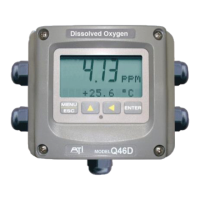ATI Q46D Dissolved Oxygen System Part 6 - Configuration
40
O&M Manual
Rev-N (4/21)
Faults are not stored; therefore, they are immediately removed if power
is cycled. If the problem causing the faults still exists, however, faults will
be displayed again after power is re-applied and a period of time elapses
during which the diagnostic system re-detects them. The exception to
this rule is the calibration failure. When a calibration fails, no corrupt
data is stored. Therefore, the system continues to function normally on
the data that was present before the calibration was attempted.
After 30 minutes or if power to the transmitter is cycled, the failure for
calibration will be cleared until calibration is attempted again. If the
problem still exists, the calibration failure will re-occur. Press ENTER to
initiate view of the highest priority failure. The display will automatically
return to normal after a few seconds.
PID Timer This function sets a timer to monitor the amount of time the PID
controller remains at 0% or 100%. This function only appears if the PID
controller is enabled. If the timer is set to 0000, the feature is effectively
disabled. If the timer value is set to any number other zero, a FAIL
condition will occur if the PID controller remains at 0% or 100% for the
timer value. If one of the relays is set to FAIL mode, this failure condition
can be signaled by a changing relay contact.
Press ENTER to initiate user entry mode, and the entire value will flash.
Use the UP arrow key to modify desired value; range of value is 0-9999
seconds. Press ENTER to store the new value.
Sim Out The Sim Out function allows the user to simulate the oxygen level of the
instrument in the user selected display range. The user enters a ppm
value directly onto the screen, and the output responds as if it were
actually receiving the signal from the sensor. This allows the user to
check the function of attached monitoring equipment during set-up or
troubleshooting. Escaping this screen returns the unit to normal
operation. Press ENTER to initiate the user entry mode, and the right-
most digit of the value will flash. Use arrow keys to modify desired value.
The starting display value will be the last read value of the input. The
output will be under control of the SIM screen until the ESC key is
pressed.
Note: If the HOLD function is engaged before the Sim Output function is
engaged, the simulated output will remain the same even when the ESC
key is pressed. Disengage the HOLD function to return to normal output.
Fail Out #1 This function enables the user to define a specified value that the main
current output will go to under fault conditions. When the Relay Option
Board is installed, the display will read Fail Out #1. When enabled to
ON, the output may be forced to the current value set in Fail Val (next
item.) With the Fail Out setting of ON, and a Fail Val setting of 6.5 mA,
any alarm condition will cause the current loop output to drop outside the
normal operating range to exactly 6.5 mA, indicating a system failure that
requires attention.
Press ENTER to initiate user entry mode, and the entire value will flash.
Use the UP arrow key to modify desired value; selections are ON, OFF.
Press ENTER to store the new value.

